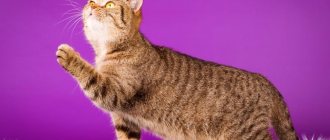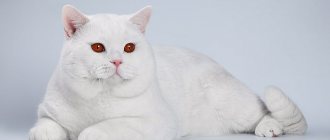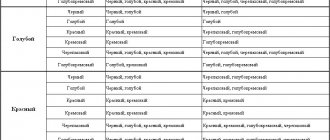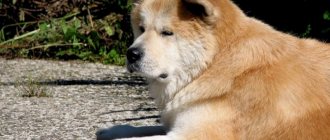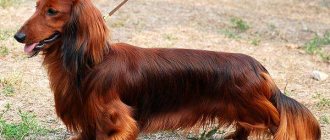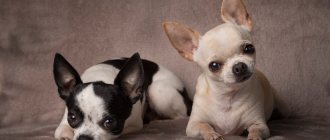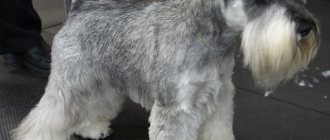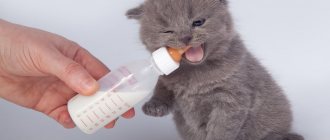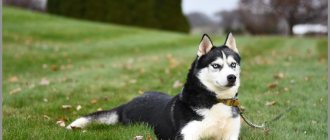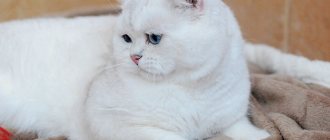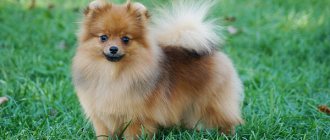Varieties of colors of British cats
The parameters of one or another color of the British include not only the color of the coat. The tone of the undercoat, the pattern on the coat, the color of the nose and paw pads, and even the color of the eyes are important. Only British kittens that strictly meet the color standards should receive pedigrees. But in practice, sometimes these rules are not observed so strictly, so when purchasing, you should only contact trusted nurseries.
Hurry up, choose a box and find out what gift awaits you
Discount on pet insurance
Promo code copied to clipboard
British cats have only two colors: black and red. The remaining colors are only derivatives of the main ones, as breeders say, by diluting (colored) and suppressing (white) the color.
In order for an animal to meet the breed standard, it is necessary that it be evenly colored, every hair from tip to root must be dyed, there should be no white hairs (excluding, of course, white color), heels and noses must be even in color, without spots, residual Tabby spots should not be visible. Eyes - orange, dark golden, copper (exceptions are allowed in white and color-point animals).
British color codes
To indicate the color of a pedigree domestic cat, a special coding is used, consisting of numbers and letters. The same color in different cat breeds will always be indicated by the same code. Each character in the color code carries important information. When filling out a document confirming that a cat belongs to a particular breed, numbers may sometimes be missing, but the letters are always indicated without fail.
The color code is deciphered using special breed tables. The first digit always indicates the attribute. The second sign indicates its variety. Each sign has its own digital designation. Thus, the presence of white in the color is indicated by the number “0”. The color of only the tip of the hairs (tipping) is indicated by the unit “1”. The presence of tabby color is coded with a two “2”, a three “3” indicates the presence of a point and indicates the length of the tail. Six “6” indicates the color of the eyes of a thoroughbred animal.
Mandatory characteristics of a cat's color are:
- description of the color of the fur, which can be plain, patterned, tortoiseshell;
- presence and percentage ratio to other white edema;
- presence of a tabby pattern;
- presence of point color;
- the presence of tipping (coloring the hair in two shades at once);
- tail length encoding;
- presence or absence of eye color coding.
The color coding of cats encodes the characteristics of the color of the coat with letters. The presence of one letter indicates that the animal’s coat is monochromatic. The presence of two letters in the code is a designation of individuals whose coat combines 2 or 3 colors. This is how the following cat colors are usually designated:
- golden;
- two-color hairs (tipped);
- tabby;
- silver;
- mixed.
Numbers may not always be in a coded description of a cat’s appearance, and letters must be indicated when compiling specific breed characteristics.
With a monochromatic color, there should be no other shades on the animal’s fur and skin, even in small quantities. The same pigment must be present on the guard hair, undercoat, if any, and on the skin.
The presence of stripes, spots or other marks on the fur requires the use of a different code classifying the animal as a different variety of the British cat breed.
The breed standard allows for the presence of small dark spots of a different shade on uniform kittens, which are called residual patterns. They usually disappear in the first year of a cat's life. Kittens are also born without a residual pattern - ticked.
Coat color code with names
To encode the colors of all cat breeds, including British ones, letter coding is used, indicating the coat colors recognized by the breed. The letters of the Latin alphabet are used as symbols:
- a ‒ blue;
- b - chocolate, brown, chestnut;
- c - lilac, lavender, platinum (lilac, lavender);
- d - red (red, flame);
- e - cream;
- f ‒ tortoiseshell, black and red (tortoiseshell, patch);
- g - blue-cream, blue-tortie (blue-cream, blue-tortie);
- h - chocolate tortoise (chocolate-tortie);
- j - lilac tortoiseshell (lilac-tortie);
- n - black, seal, sable, wild (black, ebony, seal, sable, ruddy);
- o - cinnamon, sorrel, red-brown, brown, honey (sorrel, cinnamon, honey);
- p ‒ fawn, yellow-brown “beige fawn” (beige, fawn);
- q ‒ tortoiseshell cinnamon, red-brown tortoiseshell (sorreltortie);
- r - yellow-brown, tortoiseshell (beigefawntortie);
- s ‒ silver, smoky (silver, smoke);
- w - white;
- u – bronze (bronze);
- y – golden;
- z - golden tortoiseshell (marble);
- x – color not included in the breed standards (unregistered).
White encoding
If there are white shades in the color, it is always described using a zero. Further there may be other numbers indicating the percentage of this color in the color of the animal. The absence of “0” in the code means that there are no white marks on the animal’s fur at all.
Tipping encoding
Tipping is the name for uneven coloring of hairs, in which the pigment most strongly colors the ends of the hairs. The encoding of this color is indicated by the number “1”. The following numbers encode the intensity of pigmentation. There are two tipping options for the British breed:
- 11 – when ¼ of the upper part of the hair is covered with pigment. This is shaded tipping | shaded;
- 12 – when 1/8 of the top of the hair is dyed – veiled | shell, tipped.
When the color code does not have a 1 at the beginning of the combination, this means there is no tipping.
Tabby pattern encoding
This is the name given to the pattern on animal fur. The British recognize several variants of it. In the code, such a sign is denoted by a two. The number following it indicates the type of pattern. The British recognize several tabby colors:
- 21 - striped, or agouti;
- 22 - marble;
- 23 – brindle;
- 24 - spotted.
In the case where there is no two in the encrypted description, it means that there is simply no tabby pattern on the fur of a cat of this breed.
Point color encoding
This is the name of a homogeneous pigment mask on the face, tail and paws, which is recognized today as a breed characteristic of a British cat.
In felinology, this color is called point color; in the color code it is marked with the triple “3”. The sign following it means its variety. There are three recognized types of this color:
- 31 – Burmese;
- 32 - Tonkinese;
- 33 - Himalayan, or Siamese.
When a cat does not have this coloring, the three is simply not indicated in the code.
Tail length coding
The signs describing a given breed characteristic of an animal always begin with a five. The number following it describes its features. In the breed classification of cat breeds, the following standards for tails are adopted:
- 51 – complete absence of a tail, which is very rare;
- 52 – caudal remnant measuring one or two vertebrae;
- 53 - a ponytail 7 - 13 cm long, which is also called a bob;
- 54 is a normal tail, which is fixed in short-tailed cat breeds - Manx.
When there is no number 5 in the code, it means the breed has a normal tail, as provided for in breed standards.
Eye color coding
All kittens have blue eyes at birth. Then, after one and a half to two months, they acquire a color corresponding to the color of the animal’s fur. Read more about how and when eye color changes here.
In the breed coding, the eyes are designated by the number “6”. The number following it indicates their color. In felinology, a purebred animal’s eyes can have different shades, which are assigned a special digital designation: the following variants of this breed characteristic are accepted:
- 61 ‒ blue | blue;
- 62 ‒ golden, yellow, copper, orange | gold, yellow;
- 63 ‒ individuals with multi-colored eyes | oddeyed;
- 64 ‒ green | green;
- 65 – Burmese, characteristic only of cats of this breed | burmese;
- 66 ‒ Tonkinese | tonkinese;
- 67 ‒ Himalayan or Siamese | himalayan or siam.
Photo - Eye color in British cats
In a number of breeds, when describing breed characteristics with a combination of numbers and letters, eye color may not be indicated, since the standards provide for only one option for their coloring. When several color variations are recognized in a breed, the code uses a six followed by a number indicating the color of the eyes.
Thus, a British cat with a black and silver merle color BRI ns 22 can have eyes of the following shades:
- green;
- copper
They will be designated as 62 or 64 in the color coding.
Coding of ear placement on a cat's head
This sign is indicated by the number “7”, which when deciphered means ears as such. The number following it indicates the type of placement of the ears on the cat’s head. This code is used only in pedigrees of those breeds in which the breed standard provides for several options for ear placement. For example, Scottish Fold cats can have fold-eared (Scottishfold) and straight-eared (Scottishstraight) kittens in the same litter.
In general, felinology provides the following standards for placing the ears on the head:
- 71 ‒ straight | straight or straight ears;
- 72 ‒ curl | curled or ears curled back;
- 72 ‒ fold | folded or hanging forward ears.
If a breed recognizes only one type of ear supply, the number 7 in the pedigree coding for breed characteristics is missing.
Designation of capital letters in the code.
The color code also includes two or three capital Latin letters, which indicate the length of the pile characteristic of the breed. The standard provides four options for cat breeds according to the length of the pile, which are designated by the following set of capital Latin letters:
- LH - long-haired;
- SLH - semi-longhair;
- SH - shorthair;
- SOKH - Siamese-oriental.
Solid colors of the British
Some of the solid (with an emphasis on the "o"), or solid colors - such as blue - are the ancestors of the British colors, and some - new colors - were obtained through the labor-intensive work of breeders. The rarest solid colors are cinnamon and fawn.
White
Snow-white without yellowness. Kittens may have black or gray spots on their heads from birth, which disappear with age. The eyes can be blue, and heterochromia (difference of eyes) also occurs. Breeding experiments with this color have ended because too many kittens are being born with health problems. For example, deafness in white cats with blue eyes is common.
Black
The coal-black, raven-wing colors of British cats give the animal a witchy, magical appearance. But, unfortunately, it is difficult to guess that a black kitten will become a blue-black cat. Very often, kittens change color around six months, changing the color of their fur to chocolate.
Chocolate
The richer and darker the better. Kittens that have faded from black are usually not the most successful (brown) color. Noble dark chocolate is desirable.
Blue
It can be a little lighter and a little darker. The bluer the shade, the more valuable it is. The undercoat is sometimes lighter than the main hairs, but the difference should be minimal.
Lilac
A complex color that is a cross between blue and pink. The result of selection work. Kittens are born dull pink; With age, the animal acquires a light coffee-with-milk shade, with a pinkish tint.
Cream
Beige or peach shades. Kittens can be born with a variegated coat, but then the variegation goes away.
Faun
"Deer" color, even lighter than cinnamon cinnamon. In infancy, such a kitten can be confused with a cream kitten, but the older the pet, the more clearly the gray tone appears (in cream cats, red predominates).
Cinnamon (cinnamon)
A rare color, cinnamon color, similar to light chocolate with the addition of an orange tint.
Genetics of color inheritance
There are so many colors of British cats that it’s easy to get confused among them. To organize the diversity of the color range, colors are divided into groups according to coat pattern, color and pigmentation. There are two basic colors that are directly involved in the formation of others:
- black;
- red.
Each color is formed due to a special substance - melanin. The pigment is found in a cat's hair in the form of microscopic granules that vary in shape, size and quantity. Melanin is divided into two chemical subtypes:
- zumelamine (gene B) - spherical granules that absorb light and form a black color (responsible for the black color and its derivatives);
- pheomelamin (gene A) - ellipsoidal granules that reflect light in the red range (producer of all shades of red).
The genes responsible for the offspring being red (O - orange) or black (o - not orange) are located on the X chromosome. The color of the future offspring is directly related to the gender of the parents. Females have two X chromosomes, and males have one, therefore, cats are responsible for three basic colors:
- OO - red;
- oo - black;
- Oo - tortoiseshell (red-black).
Genes located on the X chromosome are passed from mother to children. Accordingly, a red cat will not be able to give birth to black offspring, and a black cat will not produce red kittens. In cats, the color of the offspring depends on which gene is carried on the only chromosome (O or o), the choice is small - red or black. Tortoiseshell cats appear only in cases of pathology and are almost always infertile.
Cats can only be tricolor as a result of mutation.
If a cat has a tortoiseshell coloring, it means there is an extra X chromosome in his code. Characteristic gene mutations occur 1 time in 3 thousand individuals.
British black color
The dominant (dense) gene D and its companion, the recessive (diluted) gene d, are responsible for the color intensity. In order for the B gene (zumelamine) to appear and give a coal-black color, the cat must have the saturation gene D. Thus, for the formation of an intensely colored black color, dominant genes B and D must be present in the pet’s body. The recessive gene d dilutes the black color, makes it is washed out and gives lighter shades.
British black cats differ from their counterparts not only in color, but also in the quality of their coat - it is stiffer and has a characteristic, pronounced shine. This is due to the fact that the guard hair of black animals is more densely saturated with pigmentation. The signature plush coat is not typical for black individuals, but this is not considered a disadvantage.
Black British fur coats are denser and less plush.
The gene responsible for black color (zumelanin) is one of the ancient genes. Black color, along with tabby color, was often found in wild, undomesticated cats. This is why black and striped animals have a number of similar characteristics.
Color point colors
Color introduced into the breed by breeders. Sometimes it is also called “Siamese” or “Himalayan”. It has a rich palette of shades. According to the standard, a light body without spots and darkened legs, head, and tail. Wool with white undercoat. The eyes are blue, from watery-transparent to sapphire, bright blue, which is especially appreciated.
British pointing kittens are born almost white, with dark fur growing into adolescence, or even later. Over the years, both light and darker coats darken.
Black point (classic, seal point)
The most common color. On the body, the fur coat can range from white to almost chocolate color; the point markings are dark brown, turning into black. The nose and paw pads are black or black-brown.
Chocolate point
Rare beautiful color, one of the brightest. The cat's body is creamy in color, and the point markings are a rich chocolate color, which should be even and bright. The nose and paw pads are brown, maybe with a pinkish tint.
Blue point
Delicate, soft color. Cold tone. Gray-blue body and blue point markings. Looks very harmonious with ice blue eyes. The nose and paw pads are gray.
Lilac point
In this color there should be no sharp boundaries between the main color (white or almost white with a pinkish tint) and the gray-pink point markings. However, the difference in tones should be clearly visible. The nose and paw pads are gray-pink.
Red point
Quite a rare color. White or with a reddish tint coat, bright red point spots. The brighter the red, the better. Ideally, brick red color. The nose and paw pads are red to coral.
Cream point
Delicate creamy body color and smooth, easy transition to creamy point markings. The brightest spots are pink or coral nose and paw pads, as well as blue eyes.
Color point tortoises
A combination of two colors: color point and tortoiseshell. Delicate interesting color. Light body and spotted, mosaic markings. Point marks may contain a combination of any colors from the palette; soft, pastel colors are valued. The nose and paw pads match the base color.
Smoky color point
An interesting miracle of nature, or rather, the result of the work of breeders. Cats are carriers of two colors. The body can be any of the "smoke" colors: black smoke, blue smoke, lilac smoke, chocolate smoke, red smoke, cinnamon and fawn. Point markings are the same color, but darker. The undercoat is white, the nose and paw pads match the color.
Veiled color point
There are two types: on silver and on gold. On a silver-white or peach undercoat. Tipping on the back colors 1/8 of the hair in the tone of one color or another, point spots of the same color: black, blue, lilac, chocolate, red, cream, cinnamon and fawn. The nose and paw pads match the color.
Shaded color point
There are two types: on silver and on gold. On a silver-white or peach undercoat. Tipping on the back colors 1/3 of the hair to match the color of a particular color; point marks without sharp boundaries can be small. Black, blue, lilac, chocolate, red, cream, cinnamon and fawn. The nose and paw pads match the color.
Color point bicolor
Consists of two colors: white and any of the palette with point marks. As a rule, the chest, part of the body, the front legs are white, and there are also white spots on the cheeks. The symmetry of white spots and their harmonious arrangement are appreciated. Markings include black, blue, lilac, chocolate, red, cream, cinnamon and fawn. The nose and paw pads match the base color.
Fawn point
Light sandy body and light brown and beige markings. Exactly the deer shade, without the redness. Beige nose, beige paw pads.
Cinnamon Point
A very rare color, a breeders dream. Ivory coat and red-brown pointing markings. Red and pink-brown nose and paw pads.
Tortoiseshell colors
The amazing thing about calico cats is that each one is unique. There are no identically colored turtles. Color types: finely spotted or patchwork, calico (spots on white). A very interesting joke of nature: only cats are tortoiseshells. Well, practically. Calico cats are much more rare than white crows. Cats can have such colors only due to a genetic error with chromosomes. Most breeders and felinologists, having worked with animals all their lives, have never encountered tricolor cats. But yes, one day such a kitten may be born. Unfortunately, there will be no offspring from him, although history knows exceptions. Turtles also include chimera cats, which amaze everyone with their appearance, whose faces are neatly painted in different colors. Chimerism is also a genetic anomaly.
There are six main subgroups of this color: classic tortoises, smoky tortoises, torbie (tortoiseshell tabby), tortie (tortoiseshell point), calico (patchwork tortoise) and mixed color (tortoiseshell tabby and white).
Bicolor tortoiseshell
This color is also called calico, or patchwork tortoiseshell. The brightest, most elegant color. On a white background there are colored spots, the boundaries of which are not blurred or mixed. The spots can be any color from the palette. Pigmented spots should cover more than a third of the body surface. If there are few colored spots on a white background, such animals are called harlequin or van.
Black and red tortoiseshell
Ideally, a cat should have approximately 50% red and 50% black spots. The brighter the spots, the better. Brownish and beige spots are the same red color, only lightened. According to the standard, a red spot on the forehead is very desirable.
Chocolate red tortoiseshell
Interesting, rarely seen color. Ideally, a cat should have approximately 50% red and 50% black spots. The brighter the spots, the better. There should be a light spot on the forehead.
Blue-cream tortoiseshell
Soft, delicate, very noble color. Pastel colors (blue and cream) blend smoothly into each other. White spots and even hairs are not allowed.
Lilac-cream tortoiseshell
Purple and cream spots are neatly distributed throughout the animal's body. White inclusions are not allowed. There should be a cream spot on the cat's face.
Cinnamon-red tortoiseshell
Rare tortoiseshell color variant. The color of the fur coat is warm and rich. The spots are evenly distributed; there should be a red spot on the animal's face.
Fawn-cream tortoiseshell
This color is rare. The spots are not bright, but nevertheless they should have a different color. White wool and residual tabby color are not allowed. But there should be a cream mark on the forehead.
Appearance
A strong, large, powerful British cat is difficult to recognize. The characteristic appearance sets this breed apart from other cats.
The British Shorthair and Longhair breeds have a strong, broad-boned, muscular, compact, well-balanced, stocky, medium to large sized body. The weight of adult cats is 4-6 kg, males - 5-8 kg. The formation of the backbone and growth of the British is long, formed by 2-3 years. The chest is wide. The back is straight and short. The shoulders are broad and massive, as are the hips. The limbs are short and strong with rounded paws. The tail is straight, short, thick at the base and rounded at the tip. In general, the impression of everything is large, compact and round.
The British breed's head attracts attention, distinguishing it from other breeds. Round, large with a wide skull . The ears are small, set wide and low, rounded at the tips, well furred on the outside. In profile, the rounded forehead “cup” turns into a straight, short, wide nose with a noticeable transition. The muzzle is round with full cheeks. Cheekiness is a distinctive feature of the British breed. Looking at the animal, one gets the impression of a smile. The cheeks are more developed in cats; cats have a less pronounced “girlish oval”. The chin is strong, smooth, and the nose forms a vertical line. The eyes are set wide, large, round, wide open. Eye color varies from honey, orange, yellow to blue and green depending on the color. The cheekbones are wide. The neck is short, thick, powerful.
The British Shorthair breed has a short, dense (thick) coat that does not lie close to the body, is not too soft, and is of equal length throughout the entire body (average length is 2.4 mm), with a well-developed undercoat and a fine texture that creates a feeling of “plushness .
Representatives of the long-haired variety have medium-length, straight hair with good undercoat and dry guard hair. The collar and panties are developed, the tail pubescence is long and luxurious. White and color point colors are not recognized in the British Longhair breed .
Tabby colors
The main signs of a tabby (or wild color) are the letter M located on the animal’s forehead (according to legend, this is the sign of a scarab), dark stripes near the eyes and on the cheeks, as well as rings (necklace) on the neck and chest.
Marbled Tabby
Dark circles, swirls and patterns on a light background. The pattern should be clear, not tangled or intersecting.
Spotted Tabby
Stripes on the cheeks, a dotted stripe along the ridge, and spots on the sides, preferably clearly defined and bright, are required. The cat is a micro-leopard.
Striped tabby
Brindle (sprat, mackerel, striped) is the most common tabby color. Mackerel (mackerel) fish, as well as sprat fish, have tiger stripes on their scales, just like cats have on their fur, hence the name.
Distinctive features are a dark stripe along the ridge, extending onto the tail, and striped sides. It is important that the stripes are not interrupted and do not turn into spots. The cat is a micro-tiger.
Patterned with white (torbico)
Quite a rare color, consists of three: tabby, tortoiseshell, white. On a white background there are colored spots with one of the tabby patterns.
Pictured tortoiseshell (torby)
The animal has a tabby pattern under any of the coat colors (black-red, chocolate-red, blue-cream, lilac-cream, as well as cinnamon-red and fawn-cream).
Silver tabbies
The cat's fur has a black pattern (stripes, spots, marble), and a white and silver undercoat.
Golden tabbies
The cat's fur has a red pattern (stripes, spots, marble), and an apricot undercoat.
EMS code system
The coding of typical colors was developed for pragmatic purposes - in order to facilitate the work of experts at exhibitions and to help owners/breeders understand the intricacies of the coloring of their charges.
The universal encoding consists of Arabic numbers and Latin letters, various combinations of which determine the color of a particular cat. Each color has a one-letter designation:
- a – blue (blue);
- n – black (black);
- b – chocolate (chocolate);
- d – red (red);
- c – lilac (lilac);
- e – cream (creamy).
Short-haired cats are coded under the combination BRI, long-haired cats are coded under the abbreviation BLH. If a silver tint is noticeable in the coat of a British cat, the Latin S is added to the name of the color.
This is interesting! Codes that begin with the second ten belong to the pictured British, corresponding to the breed standards. The numbers will tell you about the presence of white color: the higher they are, the more pigment in the wool.
EMS coding helps felinologists quickly and accurately create a description of cats (including British Shorthairs), which takes up little space in any official documents, such as veterinary passports, metrics, certificates and pedigrees.
Return to content
Silver chinchilla
It is still a rare, difficult to breed, but very beautiful, “royal” variety of the British cat. The color is so named because of its resemblance to the fur of real chinchillas.
The beauty is the owner of a snow-white fur coat with a “spraying” of the main color tone, black or blue. No yellow shades of wool are allowed. The nose and paw pads should match the base color. The eyes are necessarily green, except for the pointed subspecies. The colors differ in the degree of coloring of the hairs.
Silver shaded
Shaded is when only the upper third of the hairs are colored in the main color. In all other respects, the animal looks like it has a solid color, only slightly “dusted.” This effect is achieved due to the fact that each hair has a colored tip. The undercoat is white.
Silver veiled
Veiling is when the top 1/8 of the hairs are colored. In all other respects, the animal looks the same as with a solid color, only in a barely visible transparent “veil”. This effect is achieved due to the fact that each hair has a colored tip. The undercoat is white.
Origin story
According to one version, British cats were brought by Roman legionnaires about 2000 years ago during the development of the islands of Great Britain. Another version interprets the French origin of this breed. There is no reliable data on who exactly brought these animals to the islands. History describes large gray cats among both Roman and French sailors, who were kept on ships to exterminate rodents. One way or another, the animals ended up in a separate territory, which allowed them to form their unique appearance. The damp and cold climate of England played a significant role in the evolution of the British breed. Due to constant winds and dampness, the wool became dense and thick. Hunting rodents has formed a strong body with developed muscles. Until the end of the 19th century, these animals were perceived as ordinary domestic cats.
In 1871, Harrison Weir organized the world's first cat show at the Crystal Palace in London . He proposed standardizing the breeds and introducing a point grading system. This time is considered the birth of the shorthaired breed . Harrison noticed that “aboriginal British” cats are different from others, they are larger, more massive, with special hair. In 1880, the first performance of these cats took place in London. In 1889, the first purebred shorthair cat was recognized. It was a white cat. In 1898, the first pedigree was issued. Until the beginning of the 20th century, selection did not divide shorthaired cats into British and European. The selection of representatives of the British breed began in the 30s of the 20th century. The official division of short-haired cats into British and European cats occurred in 1966.
The years of the First and Second World Wars affected the development of many breeds in Europe. The sharp decline in the number of British cats during the war and post-war times forced breeders to resort to interbreed matings to increase the population. Persian, exotic, chartreuse, Russian blue, European and American shorthairs were used in the breeding work. Thanks to the influx of new blood, by the beginning of the 20th century the British breed had several colors (solid, smoky, tabby, silver), although initially shorthaired cats in England were predominantly tabby. Crossing with the Persian breed quickly restored the population of large, strong animals, but fixed the gene for coat length, which gave a long-haired variation of the British breed, which is not recognized by all systems.
felinological system officially recognized the British Shorthair breed in 1980 as an independent breed with a ban on interbreed matings.
Golden chinchilla
An even rarer, difficult to breed, but very beautiful, “sunny” variety of the British cat. Its color is so named because of its similarity to the fur of real chinchillas.
This cat wears a bright apricot-colored coat with black or blue “spraying.” The brighter the gold, the more valuable it is. Gray shades are not allowed. The nose and paw pads should match the base color. The eyes are necessarily green, except for the pointed subspecies. The colors differ in the degree of coloring of the hairs.
Golden shaded
Shaded is when only the upper third of the hairs are colored in the main color. In all other respects, the animal looks like it has a solid color, only slightly “dusted.” This effect is achieved due to the fact that each hair has a colored tip. The undercoat is peach or apricot.
Golden veiled
Veiling is when the top 1/8 of the hairs are colored. In all other respects, the animal looks the same as with a solid color, only in a barely visible transparent “veil”. This effect is achieved due to the fact that each hair has a colored tip. The undercoat is peach or apricot.
Shaded
A rare but very interesting coat color in British cats. This representative is often called the “domestic chinchilla.” Popular color combinations include the following:
- silver and gold shaded British. A splash of silver should be present on the collar, paws and tummy;
- silver ticked chinchilla. The fur should be only 1/8 covered in silver. The base color remains white;
- golden cat This shade is also a real rarity, which is why it is so valued by breeders. It assumes the presence of golden inclusions, but the hairs at the roots have a darker color.
A British cat with a shaded coat will always attract the attention of your guests.
Smoky colors
“Smoky” can be any of the colors, the main thing is that the undercoat should be lighter than the main color, preferably white. This is one of the varieties of hair color distribution. About half of the hair is colored, and closer to the root half is white. There are also “cameo” colors, in which the color of the undercoat almost merges with the color of the main hairs.
Classic smoky
“Smoke” is superimposed on the same solid coat colors: black-red, chocolate-red, blue-cream, lilac-cream, as well as cinnamon-red and fawn-cream. The undercoat is silvery-white.
Smoky bicolor
The cat has a symmetrically and harmoniously distributed white color and “smoky” spots of any color. The undercoat is white, the nose and paw pads match the base color.
Care and maintenance
Unobtrusive, balanced British cats are easy to care for . Perhaps this is one of the most unpretentious breeds. The main task of the future owner is to maintain healthy coat quality, care for the ears and eyes. Due to the dense, thick undercoat, regular brushing is necessary, and daily during the shedding period.
Periodically you need to wash the animal using professional cosmetics. Regular grooming helps prevent the development of bezoars (wool stones in the animal’s digestive system), since the animal constantly licks itself, and wool entering the digestive tract can cause inflammation.
The British breed is moderate in its physical activity, therefore it is prone to obesity. A balanced diet, feeding regimen and regular exercise will allow the animal to be healthy and in great shape. Provide your pet with toys, a scratching post, and a climbing and play area.
Colors with white
A cat can have any of the following colors: black, blue, lilac, chocolate, red, cream, cinnamon and fawn, as well as a combination of these plus white spots. One fourth (no less!) part of the body should be white - this is the chest, front legs, cheeks, and belly. The nose and paw pads should match the base color.
Classic color with white
Strictly speaking, this is a two-colored cat. Elegant white spots (yellowishness is not allowed) and a fur coat of any of the classic colors. The nose and paw pads match the base color.
Smoky color with white
The cat has a symmetrically and harmoniously distributed white color (chest, paws, cheeks) and “smoky” spots of any color.
Color point with white
The elegant coat of such a cat is painted in two colors: white and any of the palettes with point marks. The chest and front legs are white, and there are also white spots on the cheeks. The symmetry of white spots and their harmonious arrangement are appreciated. Markings of black, blue, lilac, chocolate, red, cream, cinnamon and fawn. The nose and paw pads match the base color.
Colors with white tabby
The same patchwork turtles, only some spots may have a tabby pattern. Rarely seen, it is considered a combination of three colors. There may also be spots of the same (any) color, on which a tabby pattern appears (stripes, spots, marble).
White and color point kittens
These cats have a distinctive feature - blue, green or copper eyes. At the same time, the color coding indicates the feature. White kittens are often born with small markings. Their color is dull and their sizes are minimal.
Just like with black solids, they disappear as they grow older. White kittens of the British breed cannot have a warm shade, only a pure and bright color.
Important: White color is distinguished from cream by the color of the nose. The latter have a warm shade. Cream is a derivative of red color in a lightened version.
Color point kittens have markings on the face, tail, paws, and darkened fur on the back. The main background is light. The unusual color was inherited from exotic breeds. The markings may have a tabby pattern. The background colors are black, purple, cream, red and chocolate.
How to determine the color of a British cat?
If you really need a kitten of a certain color, you should contact a cattery with a good reputation. It’s not a fact that you will immediately find what you want, especially if the color is rare. Ask for photos, videos; Perhaps they will show you the baby on Skype. Then it’s time to go and choose.
To begin with, visually, but the kitten must already be mature (3-4 months). In babies, the color may change color.
Look at the kitten's parents, talk with the owners, study the breed codes and the summary color table. The exact details of cat fathers and mothers must be indicated in their documents. Using the table, you can determine which kittens a given pair of producers may have.
Well, or you can contact a specialist, an expert felinologist. In the case of rare and complex colors, it is better not to take risks. Interestingly, all cats are initially wild-colored (tabby). That is, spotted. But due to a combination of genes, this color is hidden. Nature's jokes can be observed in small kittens, which, being born with spotted fur, change to one color within a couple of months.
Black British coat care
The coat of a black British cat will look perfect if you follow some rules:
- Black Britons, like everyone else, need proper nutrition. The diet should be balanced and varied. There are two feeding options: natural food or ready-made food (super premium line). Breeders do not recommend mixing dry food and natural products, as this can lead to gastrointestinal diseases in the animal. If a cat eats natural products, then its menu should include the following products:
- chilled lean meat or poultry breast;
- boiled sea fish;
- dairy products;
- vegetables and finely chopped greens;
- poultry eggs;
- kelp algae, which maintains the black color of the coat.
Algae maintains the black color of the British coat
- Since the coat of the black representative of the British breed is darker and coarser than that of its relatives, it gets dirty less and is easier to clean. Therefore, you should bathe your pet no more than once every six months. The Briton should be washed with special shampoos, preferably premium ones. Reasons for giving your pet an emergency bath:
- participation in exhibitions and competitions;
- severe contamination of the wool with something sticky, sticky or toxic;
- independent visit to the street;
The British are very clean animals, so they should not be bathed often.
- getting rid of tangles;
- removal of stuck impurities.
- The Black Briton needs to be brushed once a week with a slicker brush or a special fine-toothed comb. During molting, the animal needs to be scratched more often - about once every two to three days. A cat should be taught hygiene procedures from a very young age, otherwise the pet will be reluctant to accept them.
- For large British dogs, you should choose a spacious and comfortable tray and filler that does not stick to the animal’s fur.
- The Black British cat, like any domestic cat, needs annual vaccination and prevention of parasites.
British cats are prone to obesity, so you need to carefully ensure that they do not overeat. The slightest disruption in health can lead to a deterioration in the quality of the coat and loss of natural shine.
When we took our British cat from the breeders, they warned us that it was better to feed the animal natural products. The diet must include raw lean meat. The breeder advised us to immediately cut the purchased veal into long pieces and package it in portions. Before eating, the meat must be doused with boiling water. When chewing long bars, British children develop a correct bite and plump, as if stuffed cheeks, forming a unique “Cheshire smile.”
